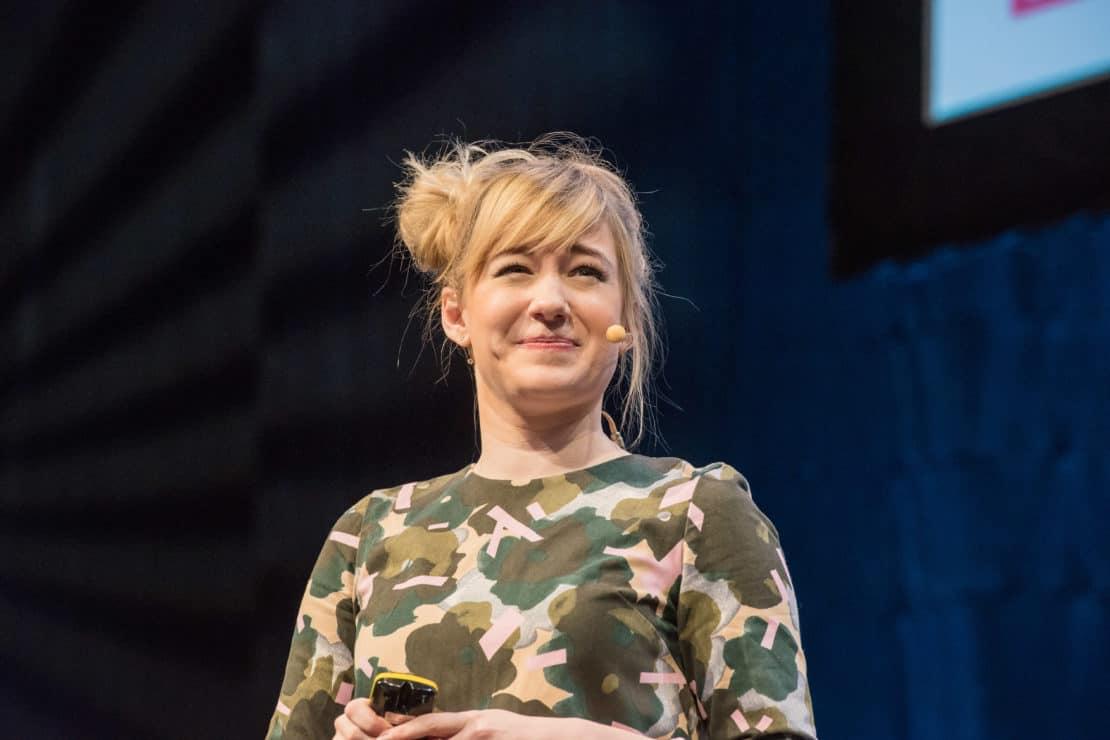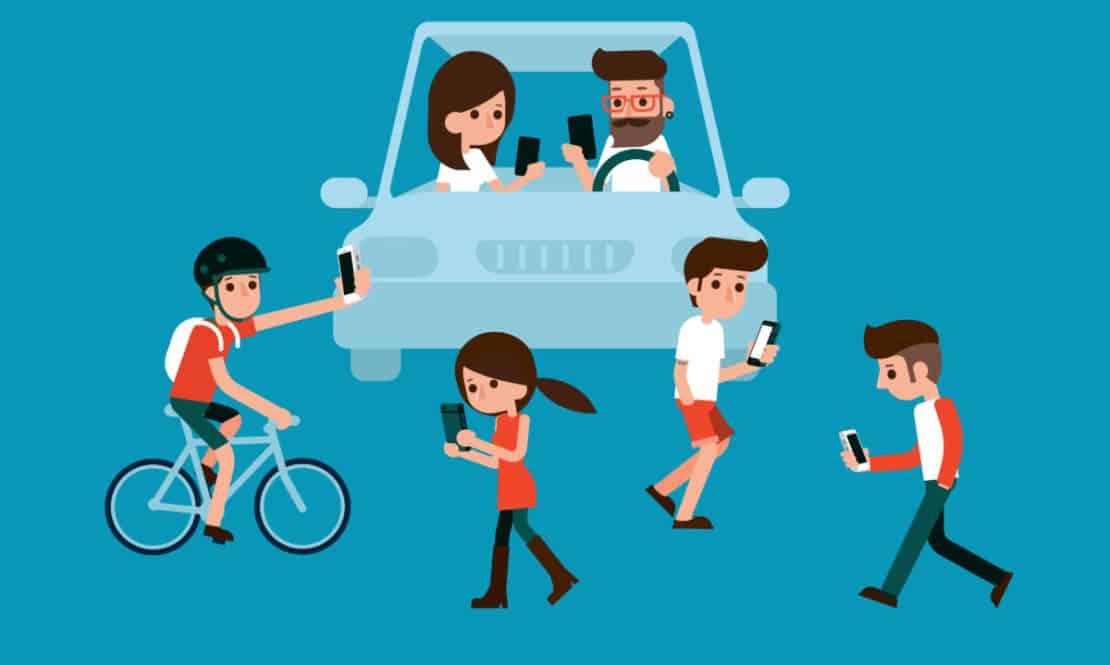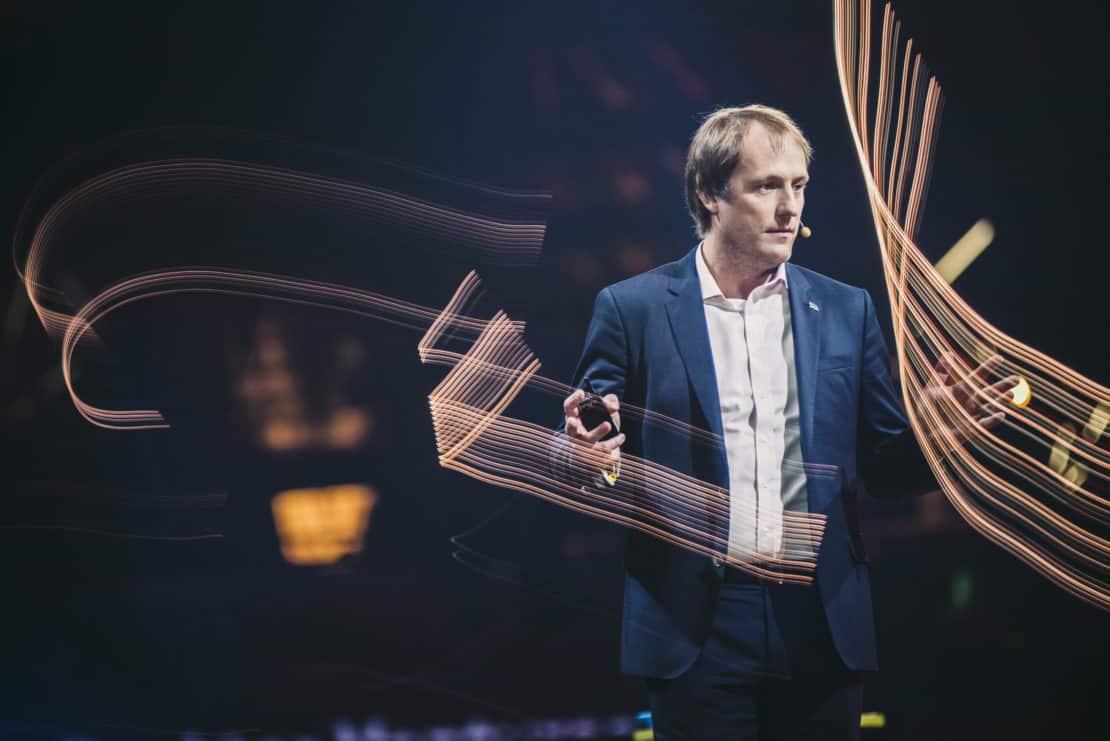20Mar2017
Linda Liukas stands on the stage of the Nordic Business Forum with a smile that competes with the house lights in terms of brightness. It’s big enough that her eyes are nearly closed to allow it the real estate it needs. And once she begins to talk about what she does, and its importance, it’s easy to see why that smile is so big. She sees a bright future for us—despite all of the fear about machines that pops up in conversation.
She wears a long-sleeved camouflage pattern shirt—unusual, due to the presence of pink in it—and shiny black leather pants. She introduces herself as “Linda…a business school dropout.” But when she explains that she was able to raise over $380,000 on Kickstarter for her children’s book Hello Ruby before it was even written, it makes one think that she probably made the right choice. Hello Ruby has now been translated into over 20 languages, and Liukas travels the world teaching kids about computers.
Her goal, as she sees it, is to “prepare kids for a world where every single problem will be a computer problem.” Biology, transportation, and governing, she predicts will increasingly become problems of computation, more than anything else.
In Liukas’ mind, the best way to do that is to get inside of a computer, and better understand how it works. But there was a problem: computers had gotten so small, that it’s practically impossible to do so. Despite that, she found a way, which was the premise for her book.
In the book, the main character—6 year-old Ruby—wanders into her dad’s office and tries to log on to the computer. When it doesn’t work, the mouse comes to life and takes her on an adventure to find the lost cursor, deep inside of the computer. The journey takes them from electrical charges, to logic gates, to capacitors, resistors, and operating systems. In the end, of course, they find the cursor, and all is well.
Liukas explains that a book like hers was necessary because the way that computers have been advancing has been through abstraction. Each innovation, improvement, and new application in computing has taken the user further away from the actual commands and mechanisms of the machines. The result is a world of users who barely know anything past the icons on the touchscreen. Understanding has been lost, and with it, the ability to imagine what else they can do.
Computers used to be like bicycles, but their advancement has made them more like compact sports cars. But Liukas has a plan to catch us in our free fall away from understanding: “I’m talking about teaching kids to see the computer as the bicycle of the mind.”
Liukas suggests that, like dedicated bicyclists, we “get to know the machine again.“ In doing so, she hopes, we can begin to use technology as a way to enhance our humanity, rather than to whittle it away.
There are three things that Liukas thinks getting closer to computers can teach us:
1. A logical approach to all problems.
2. An understanding of what the possibilities are for the future.
3. A vocabulary
“The programmer, much like the poet,” Liukas articulates “creates out of nothing. Programmers create these little universes where they create the vocabulary, and the words, and the rules, and the grammars. And they create it with the pure power of logic—with only words.”
In one of the exercises that Liukas does with the children she teaches, she gives them a sticker that looks like an on/off button. They are encouraged to put it on anything they can think of, in order to make that thing a computer. In one instance, a little girl put it on a bicycle lamp—an almost antiquated-looking piece that Liukas put up on a slide. The girls told Liukas that if she could make a bicycle lamp into a computer, she could go on biking trips with her dad, and then as they sleep in the tent, they could watch movies—because the bicycle lamp would be a projector. Liukas’ eyes light up with joy. “That,” she says beaming “is the moment I’m looking for.“
At that moment, Liukas says, the child realizes three profound things:
1. “The world is not ready yet“
2. “Technology is a wonderful way to make the world a little bit more ready.” Technology scales, after all, and it helps create wealth. It helps to build the world.
3. That he or she can be a part of this change. Just by having tinkered with things, she has stumbled upon that spark that is part of being an innovator in this new kind of world. She has demonstrated agency, which encourages further development. That is exactly, Liukas explains passionately, what we ought to be encouraging in kids—that agency, that wherewithal to be a part of the change that is making the world ready for the future.
Every Company Will Be a Technology Company
It is on the heels of that claim that Liukas makes an even bolder one: “Every company will be a technology company going forward.”
She says this because the resources that used to be scarce, like money, are no longer scarce for most companies. What is scarce, Liukas says, is that bold and visionary spirit that will imagine and implement the new and impactful changes. Technology, she tells the attentive crowd, is what makes these changes happen faster. Thus, companies who can master technology faster and harness its power have the advantage. It follows that people who can do that as well, can have entire industries in the palms of their hands.
For Liukas, computers are becoming much more than the original Von Neumann machines—merely taking in the input of commands, and manipulating data based on the commands. Machines are now perceiving. After all, they can spot people and animals in photos and videos. For Liukas, that represents a first step in what the division of labor will look like between humans and computers. “Perception is the first step toward imagination,” she says. “And imagination is the first step toward creativity.”
When computers can imagine and then create, they are stepping into what has been heretofore classified as the uniquely human domain. The accompanying worry is that human creativity and expression are in danger.
But Liukas asks us to remember something. “Technology,” she says “is built on humanity.” As she explains, the very first computers were just very intelligent humans who were very good at doing long calculations. She then makes a prediction: “And I for one believe that the last computers in the world will also be human.”
Why does Linda Liukas believe this? It’s because technology has a wider definition than we usually acknowledge. “The word ‘technology,’” she explains “includes the problem-solving tools, but it also includes the skills and competencies alongside those tools.” Those are, as she sees it, all too human.
But if that’s not enough to calm the worrisome onlookers in our society, she presents one more exhibit. It’s a slide with what is obviously a child’s writing on lined paper: the unvarnished thoughts of a child in one of her classes who has grown up with AI, neural networks, and all of the “scariest“ technologies right at her fingertips. When asked what technology is, her short explanation closed with the sentence “People uses [sic] technology.” That is an important distinction to remember. Technology is there for us to use, but we still need to have things we aim to use it for. We still need vision and aspirations.
Liukas, seemingly smiling just as widely now as she was 20 minutes ago, reminds us in her uniquely upbeat voice: “Computers are binary. They can be one thing or the other. But us humans, we contain multitudes. We can be many things at the same time. Crafters…programmers, and poets, and I believe that’s the best roadmap we have for the future.”
This article is a part of the Executive Summary of Nordic Business Forum SWEDEN. Get your digital copy of the summary from the link below.


